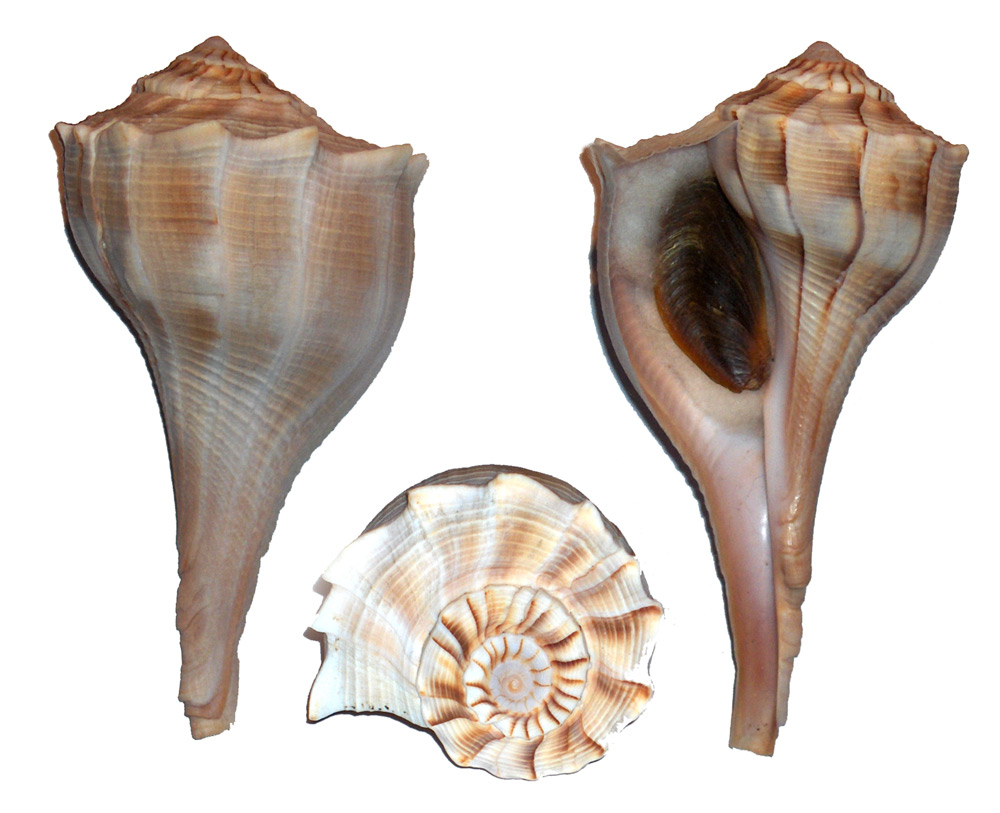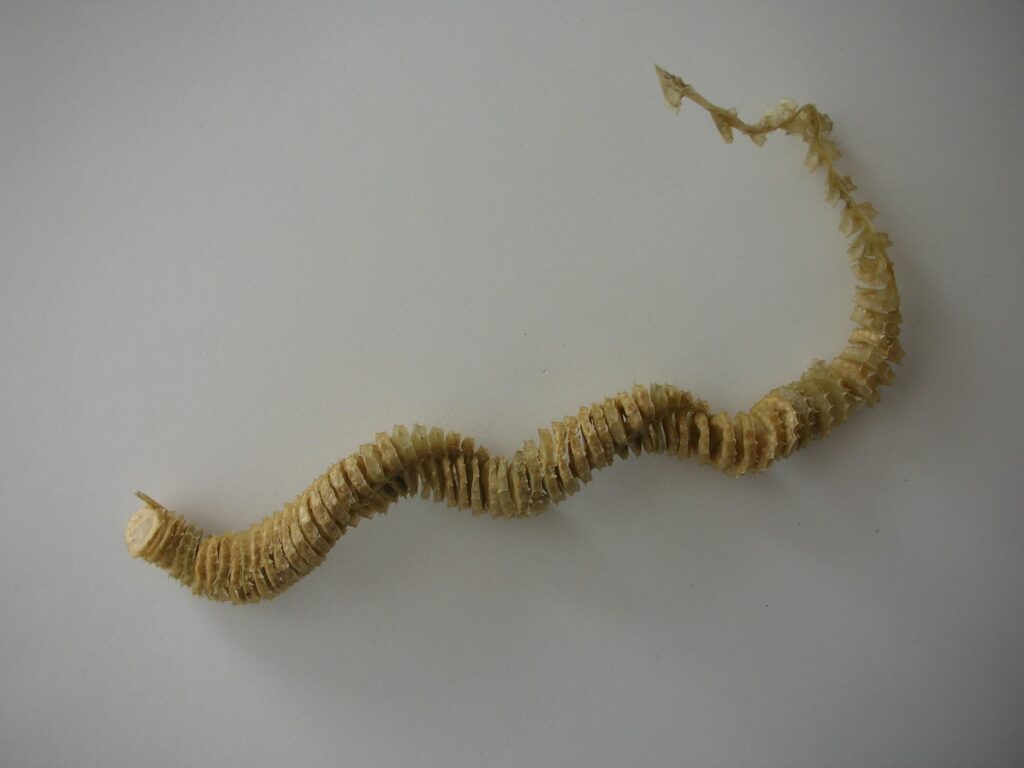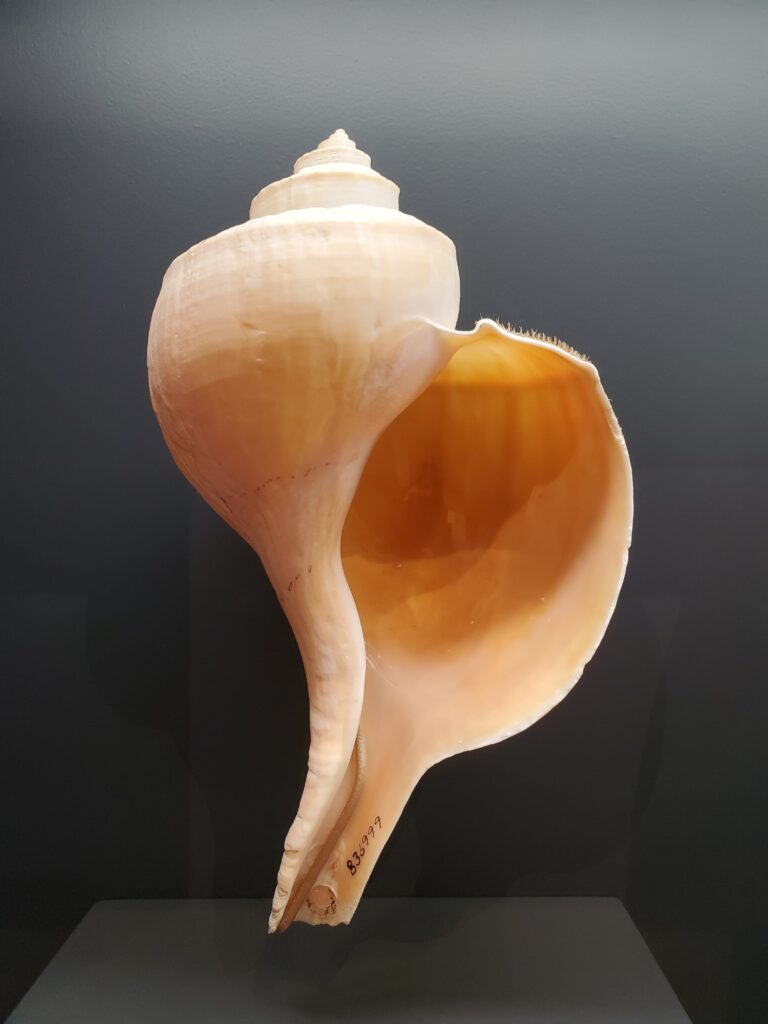by Sabrina Spiher Robinson and Tim Pearce
We try not to have strong favorites among the mollusks of the world in the CMNH Section of Mollusks, but it’s hard not to love the whelks. They leave behind big, beautiful shells for shell collectors on our east coast and Gulf beaches; they’re instantly recognizable as a family— Busyconidae — and pretty easy to tell apart at the species level by an amateur. Some of the species are sinistral, left-coiling snails, which are otherwise rare among gastropods. They live long and move slowly, reminding us all that slow and steady is an optimal way to approach life. They taste good! The traditional Italian American dish scungilli is often described as “conch,” but conchs only live in our warm southern waters, and what is usually sold in American markets for scungilli is actually whelk meat. (In Italy, they also eat sea snails, under a lot of different names, but the Mediterranean has different families of marine gastropods.)

Now, whelks are maybe not the most sophisticated of marine snails: unlike some gastropods with eye stalks and relatively good sight abilities, whelks have eye spots, which don’t do much more than detect light and dark. Studies of their sense of smell reveal them to have a tenuous ability at best to follow scent trails of prey in the water, and they’ve been observed just kind of slowly zig-zagging back and forth in the mud, apparently hoping to run into a clam. Once they find a clam, some whelks wedge the edge of their own shell between the valves of their prey, and just pry for as long as it takes to pop it open. Other species of whelk rock the edge of their own shells back and forth against the opening of a bivalve, slowly chipping its valves apart.
I mean, look: it isn’t much, but it’s honest work. Whelks are just a great family of sea snails. And Busycon whelks are endemic to the east coast of North America, meaning they’ve only ever been found here. Hometown heroes, if you will.
Our east coast whelks are committed homebodies partly because they evolved relatively late among mollusk families, in the Oligocene, a period spanning from 33.9 – 23 million years ago. The family Busyconidae first emerged in the fossil record in the Mississippian Sea, which had been a shallow extension of what is now the Gulf of Mexico that reached far inland along the route of what is now the Mississippi River. At the end of the Oligocene, the planet’s climate cooled and as ice formed at the poles, sea levels fell, eliminating this inland sea in North America — the whelks then found themselves in the Gulf.
Mollusks have existed on Earth clear back to the Cambrian Era, 540 million years ago. Most modern marine gastropod families began evolving earlier than the Busycons, which meant they were around when all the continents on Earth were one giant supercontinent called Pangea. But Pangea had already broken apart before the Busycons appeared in the fossil record.
Now, here’s the thing, if you are a marine gastropod only suited to shallow, intertidal waters, and you come into being along the coast of a supercontinent, given enough time, your family can spread around the entire coastline of that supercontinent. Then, as it begins to break up, your populations break up with it, and in a few dozen millions of years, your family has populations all over the Earth. But if you are a marine gastropod only suited to shallow, intertidal waters, and you come into being when the North Atlantic has already split from Europe, your family can’t make it across the open sea to go anywhere else. And so, the Busycon family of whelks found themselves in the Gulf of Mexico, near the shore, and began to spread from there, east and west, south and north, until today they exist from the Yucatan Peninsula up to about Cape Cod (it gets too cold for them further north).

Buccinidae whelks, however, can handle arctic cold. They first evolved in the Northeast Pacific Ocean, and they eventually spread along the coastlines across the Bering Strait and down onto the North American west coast, across the Canadian Arctic to the North American east coast and the European eastern Atlantic. They’ve actually made it almost everywhere! But Buyscons can’t take that kind of cold.
There are other factors that limit their spread, one is the ocean currents around the Gulf and western Atlantic. Although Cuba is just 90 miles from the Florida Keys, whelks, which are plentiful in Florida, have never managed to cross the Gulf Stream to colonize Cuba. But one of the main things that keep Busycon whelks from getting anywhere is that, unlike most marine mollusks, they never have a free-swimming larval form, in which they could disperse more widely on ocean currents. Most marine snails have a life cycle that starts with an egg and then proceeds after hatching to a free-swimming larva. Basically, most baby marine mollusks are plankton. And in this state, they can float around and sometimes disperse pretty far afield on ocean currents. As long as they end up in suitable habitat when it’s time for them to metamorphosize into their adult forms, marine mollusks can theoretically end up living hundreds of miles from where they were spawned.
But whelks don’t have this free-swimming period in their youth. Adult females are inseminated directly by males and then lay strings of egg cases (which are also reliably common finds on our eastern beaches) in which the little baby whelks grow and hatch as fully formed miniature snails. Then they just crawl off.

And they’re not very fast crawlers, even for snails. Whelks make their living by eating bivalves, but they’re never in a hurry to find them — in multiple observational studies over many decades, no one has ever seen a Busycon whelk move further than 150 meters in a day, and those go-getters were the outliers; many days whelks barely move at all. Many factors conspire to keep whelks close to their birthplace.

Whelk populations are so localized that some researchers think it’s important to identify and treat separately groups of whelks in distinct geographic locations not at all far from each other. In 2022, several scientists at the Virginia Institute of Marine Science (VIMS) published a paper on channeled whelks (Busycotypus canaliculatus) documenting their genetic diversity in different geographic locations. They did this as part of a study of the channeled whelk population in general, to recommend how to manage the whelk fishery. (Whelks are increasingly harvested and sold as “conch” – and sometimes as clam strips!) In America, individual states manage their own fisheries of all kinds, but this isn’t always done well. In order to keep the fishing of any species (fish, mollusk, crab, shrimp, what have you) productive and sustainable, it’s important not to take more from the sea than can be replenished, and not to take animals that haven’t lived long enough to have reproduced (which is why some fisheries have size limits, as a proxy for the age and sexual maturity of the animal being harvested). But without good data on population size as well as age and size at sexual maturity, effective management and limit setting is basically impossible, and too often states don’t err on the side of caution. When allowable takes are too large, or allowed to include juvenile animals, the population of the fishery will plummet, and this has happened in different places and different times among the whelks. So, the VIMS project was meant to contribute data to help manage the whelk fisheries along the east coast sustainably.
The VIMS scientists caught whelks in ten different locations, from Buzzards Bay in Massachusetts down to Charleston, South Carolina, and sequenced their DNA. They found significant genetic divergence between the three sampled populations from the Carolinas and the populations in Virginia and north. But the scientists also found pretty big divergences across all the locations, even in populations as geographically close to one another as Virginia Beach, VA, and the Virginia Eastern Shore, about a hundred miles away across the mouth of the Chesapeake Bay.
Morphologically, all these whelks look pretty much alike, but genetically, they’re very isolated and distinct populations, with very little breeding among locations. Busycon whelks stay so close to home that each of their little geographically specific populations genetically diverge from one another since they never get far enough to meet and mate with whelks in other relatively close locations. The VIMS authors suggested that different whelk populations in different places might require different fishery management based on size at age of maturity, which seemed to change across genetically different populations. And so, it isn’t as simple as managing the “whelk fisheries on the east coast,” or even the “whelk fisheries in Virginia.” Because Channeled whelk populations are so isolated from one another, they might need to be managed as fisheries in Charleston, SC and Ocean City, MD, and so forth, specifically. [1]
After all that, I should tell you, though, that there is one exception to this east coast endemic story: at some point about a hundred years ago, a population of channeled whelks was introduced to San Francisco Bay. They’ve been prospering there ever since, but they can’t spread any further on the west coast because the water outside the bay is too cold for them. That’s an extremely genetically isolated population, in an unusual environment for Busycon whelks – maybe someday it might become distinct enough from its east coast forebears to become its own species?
[1] Askin, Samantha E.; Fisher, Robert A.; Biesack, Ellen E.; Robins, Rick; and McDowell, Jan, Population Genetic Structure in Channeled Whelk Busycotypus canaliculatus along the U.S. Atlantic Coast (2022). Transactions of the American Fisheries Society. DOI: 10.1002/tafs.10374
Sabrina Spiher Robinson is Collection Assistant for the Section of Mollusks and Tim Pearce is Head of the Section of Mollusks at Carnegie Museum of Natural History.
Related Content
Oysters Swim Towards a Siren Soundscape
Slipper Snails Slide Between Sexes in Stacks
The Hermit Crab and the Moon Snail
Carnegie Museum of Natural History Blog Citation Information
Blog author: Pearce, Timothy; Robinson, Sabrina SpiherPublication date: July 26, 2024
